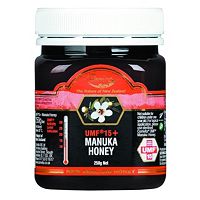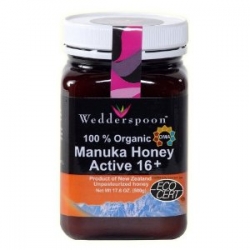Manuka honey is a pricey health product used increasingly for its claimed antibacterial properties – Scarlett Johanssen and Katherine Jenkins are fans – but authorities have claimed that much of what’s on the shelves may be fake
The UK Food Standards Authority has issued a warning that honey labelled manuka may not be genuine. Prices for the superhoney range from £12-£60 a pot.
The Sunday Times yesterday reported that research by the main honey producers’ organisation in New Zealand revealed that only 1700 tons of manuka are produced a year. Yet 1800 tons of honey labelled manuka are sold in the UK alone and some 10,000 tons worldwide.
It’s prompted a worldwide food fraud investigation.
Manuka honey is produced by bees whose hives are placed near wild manuka bushes (the flower in the picture above) grown only in New Zealand’s north island. In 1981, a New Zealand scientist claimed it had anti-bacterial properties.
Yet, when the UK Food and Environment Research Agency (FERA) tested five UK brands in 2011 they found only one showed the ‘non-peroxide’ anti-microbial activity that is the famed ingredient unique to genuine manuka honey. In further tests of 23 manuka-labelled honeys, 11 more failed the non-peroxide tests.
But as far back as 2006 scientists have been aware of the variations in non-peroxide activity in manuka honey as this study shows and some say is due to dilution of the honey with other, non-manuka honeys.
How can you know what you’re buying? You can’t is the short answer as there is no standard internationally recognized labelling system that authenticates manuka honey.
However, right now closest we have is the Unique Manuka Factor (UMF) trademark, which is a license issued to approved manuka producers by the Unique Manuka Factor Honey Association (UMFHA) of New Zealand.
If a producer is on this list of UMF licensees, the chances are their product is genuine. From there, the higher the UMF the higher it’s claimed is the non-peroxide anti-bacterial activity – and the higher the price.
But don’t be confused by there being a number on the jar. Some jars list ‘TA’ or ‘total activity’ which measures the ‘hydrogen peroxide activity’ but this is not only common to all types of honey, it’s not stable so can reduce while jars are on the shelf.
So what’s manuka honey proven to help? Research from the University of Wales Institute found it could help fight superbugs like MRSA by helping wound infections heal without the development of antibiotic resistant bacteria (as antibiotics do). Read more The main and most proven use for manuka honey is for treating minor wounds and burns. Read more There is some minor research that it might also help help reduce gum disease. Read more
How to know what you’re buying is the real thing
Earlier this year the UMFHA released their ‘Know your Manuka Honey’ campaign which set out to help consumers ensure they’re buying authentic manuka from licensed makers.
The UMFHA is an independent body which regulates the the UMF trademark through the maintenance of stringent testing. Though you still can’t be certain the product you’re buying is authentic, looking for the UMF trademark and checking your supplier is on the list of UMFHA licensees is a good starting point. Look on the front for the UMF trademark.


The UMFHA has forged links to FERA and if you’re worried, we suggest you email the UMHA and ask if you can can submit your manuka honey for testing to them.
Like this article? Sign up to our newsletter to get more articles like this delivered straight to your inbox.




















































